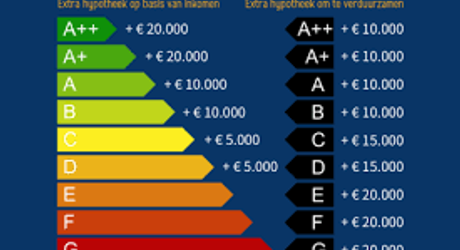Mortgage Rates: A Slow but Steady Decline
As we step into 2025, the Dutch mortgage market presents a complex mix of opportunity and caution. One of the most significant developments is the gradual decline in mortgage interest rates. After a turbulent few years driven by inflation and global uncertainty, there is now a sense of cautious optimism.
Inflation in the eurozone has dropped to 2.4%, getting closer to the European Central Bank’s (ECB) long-term target of 2%. The ECB anticipates further declines in inflation throughout 2025 and 2026, even expecting a slight dip below the 2% benchmark. In response, financial markets are seeing lower interest rates, and this is beginning to reflect in mortgage products.
As of early 2025, the average 10-year fixed mortgage rate with NHG (National Mortgage Guarantee) stands at around 4.4%, while mortgages without NHG and with 100% financing are priced closer to 4.7%. Market analysts expect that the 10-year fixed rate will gradually fall to between 3% and 3.5% by the end of 2025. Looking further ahead, if the economy remains stable, rates could drop below 3% between 2027 and 2030. However, experts do not anticipate a return to the historically low levels of 1% to 2% seen during the COVID-19 pandemic. The ECB has learned from that period that overstimulating the economy with ultra-low or even negative rates can undermine long-term financial stability.
Choosing a Fixed Rate Period: More Than Just a Forecast
Although the outlook for interest rates is promising, choosing how long to fix your mortgage rate remains a deeply personal decision. Predicting interest rate trends with certainty is almost impossible, especially in a world filled with geopolitical tensions and economic volatility.
What if Donald Trump is re-elected in the United States? What if tensions between China and Taiwan escalate? What if conflicts in the Middle East spread or if the war in Ukraine takes an unexpected turn? These kinds of global disruptions often lead to uncertainty in financial markets, which in turn can cause interest rates to rise.
Therefore, when choosing a fixed-rate mortgage, it’s best to base your decision on your financial comfort and risk tolerance. Ask yourself:
-
How long do I want payment stability?
-
Can I afford higher monthly costs if interest rates rise after my fixed period ends?
-
Would I regret locking in a long-term rate if rates fall in the future?
There’s no one-size-fits-all answer—but these are the questions every buyer should consider.
Supply Shortage Continues to Push Prices Up
While interest rates are slowly falling, housing prices in the Netherlands continue to climb, driven by a severe shortage of supply. In 2024, only around 70,000 new homes were built—far below the annual target of 115,000. Various issues continue to plague the construction sector, including a shortage of qualified workers, soaring building costs, and delays caused by environmental regulations, particularly around nitrogen emissions.
Even Amsterdam, one of the country's most in-demand housing markets, has had to scale back its building plans due to regulatory obstacles. While the Dutch government is working on new legislation (such as the proposed “regiewet”) to speed up housing development and take more centralized control, significant relief for the housing crisis is unlikely to materialize in the short term.
Housing Prices in 2025: Still Rising
The result of limited supply and ongoing demand? Rising property prices. In 2024, the average home price in the Netherlands increased to €451,000. In 2025, that figure is projected to climb further to around €488,000.
In major urban regions like the Randstad, average prices have already exceeded €500,000. According to market forecasts from leading banks:
-
Rabobank expects an 8.6% price increase in 2025.
-
ABN AMRO forecasts a 7% rise.
-
ING projects 5.5% growth.
-
De Nederlandsche Bank (DNB) anticipates a 7.5% increase in 2025, followed by 4% in both 2026 and 2027.
Higher wages and lower interest rates have increased borrowing capacity, enabling more buyers to enter the market and bid higher—further fueling the price surge.
What Can You Expect to Pay?
In today’s market, prospective buyers should be prepared for substantial prices, especially in and around major cities. Typical prices in 2025 include:
-
Apartments in desirable urban neighborhoods: starting from €450,000
-
Terraced family homes (eengezinswoningen): around €575,000
-
Semi-detached houses (twee-onder-een-kap): approximately €750,000
-
Detached homes (vrijstaande woningen): easily over €1,100,000
These figures highlight the need for thorough financial planning and expert mortgage advice.
Conclusion: A Competitive Market With Long-Term Opportunities
With interest rates easing and wages rising, 2025 offers more financing room for buyers. However, ongoing housing shortages mean that prices will likely continue to rise. If you're planning to buy, waiting for a market dip may not be realistic. Acting now—with good advice and a clear financial plan—may be the smartest move.
The key takeaway: falling rates and high demand are pushing prices up, and buyers should focus more on personal affordability and long-term value than trying to time the market.






